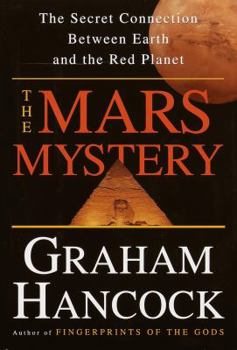The Mars Mystery: The Secret Connection Between Earth and the Red Planet
Select Format
Select Condition 
Book Overview
In The Mars Mystery, investigative archaeologist Graham Hancock treats our growing knowledge of Martian topography as a Rosetta Stone we can use to decode mysteries as old as the human imagination. He examines the current landscape of Mars and discovers evidence that the planet was once home to a lush environment of dense atmo-sphere and flowing rivers, lakes, and oceans. He asks questions, based on growing evidence, that cannot be dismissed: Has Mars ever sustained higher forms of life? How might the secret history of Mars be intertwined with Earth's own past and future? In his most riveting and revealing book yet, Hancock points to the intriguing possibility that ancient Martian civilization is communicating with us through the remarkable structures it left behind. Megaliths found on the parched shores of Cydonia, a former Martian ocean, mirror the geometrical conventions of the pyramids at Egypt's Giza necropolis. Especially startling is a Sphinx-like structure depicting a face with distinguishable diadem, teeth, mouth, and Egyptian-style headdress. Might there be a connection between the structures of Egypt and those of Mars? Yet, as intriguing as scientists all over the world find the Cydonian discovery, NASA continues to balk at taking a more detailed look at the site and has veiled previous photographs and studies in a web of equivocation. In The Mars Mystery, Hancock makes a strong case that NASA is motivated by a lingering Cold War mentality and a fear that evidence of alien life will have destabilizing political, economic, and social consequences. In exploring the traces left by the Martian civilization and the cosmic cataclysm that may have ended it, The Mars Mystery is both an illumination of our ancient past and a warning which we still have time to heed about our ultimate fate.
Format:Hardcover
Language:English
ISBN:0609600869
ISBN13:9780609600863
Release Date:June 1998
Publisher:Crown
Length:344 Pages
Weight:1.50 lbs.
Dimensions:9.3" x 1.3" x 6.5"
Customer Reviews
3 ratings
Bridges built out of yearning.
Published by Thriftbooks.com User , 16 years ago
"The great systems that inform the world about the truth and life invariably claim to be absolutely truthful and well-balanced. In reality they are quaking bridges built out of yearning." Thus, the protagonist of this short story collection's last entry, "Reflection of a Young Man in Balance," sums up what he has come to learn about love, and life in general. However, these could also be the words of almost any character in any of the other tales told here: Admittedly or unadmittedly, they are searching for something, for a defining point or experience in life, and all of them see their lives profoundly unbalanced by that experience. Taking "love and its conditions on the night of March 19, 1929" as his point of reference and as a link between the otherwise unconnected eight stories, Peter Hoeg takes his readers from Denmark around the world to Paris, Lisbon and Central Africa. In a language and in settings somewhere between Dinesen (the obvious comparison), Conrad, Hemingway, Wilde and Poe, the author of "Smilla's Sense of Snow" takes a look at the human condition, society in the first decades of the 20th century, and the dichotomy of science and sentiment, experience and emotion, logic and love. In "Journey into a Dark Heart," a historic train ride in Central Africa turns into a life-changing adventure for a young, disheartened mathematician, with travel companions such as German war hero General von Lettow-Vorbeck, traveling writer Joseph Korzeniowski (a/k/a Joseph Conrad, whose "Heart of Darkness" provides the obvious inspiration for more than just the story's title) and an African servant girl with her own surprise in store for the three men. "Hommage a Bournonville" finds a young Danish ballet dancer on a tiny boat in Lisbon's harbor, telling the story of his lost love to a dervish of Turkish origin cast together with him by fate. In "The Verdict on the Right Honorable Ignatio Landstad Rasker, Lord Chief Justice," a father chooses the occasion of his son's marriage to pass on the story how his own father, a renowned jurist and civil servant, faced up to the demons he had suppressed for most of his life, and which his family thereafter promptly continued to suppress. "An Experiment on the Constancy of Love" juxtaposes a young woman of means and great beauty, an aspiring scientist with a sheer endless disdain for life, and the man who becomes her suitor from their first childhood meeting on and follows her from Paris to Denmark and back to Paris, until their ambitions and sentiments collide head-on in a fatal experiment she has devised. "Portrait of the Avant-Garde" takes a successful, ambitious painter with ties to the rising Nazis to a nightly boat trip into self-discovery off a remote Danish island. "Pity for the Children of Vaden Town" is the story of a city's self-elected utter isolation, and of the pied piper who has come to the town children's rescue - with abounding reminiscences to the Grimm Brothers, Robert Browning, Hans Chr
The Mars Mystery
Published by Thriftbooks.com User , 22 years ago
Excellent book, All I can say is that if your interested in Mars or the true or possible history of man this book will bend your mind in a totally new directions. A Very cool book, a very cool edition to any personal library.
Listen, Learn, Read On
Published by Thriftbooks.com User , 25 years ago
I have finished reading the book a few weeks ago and now that all the emotions have settled down, the impression that is left is of a highly entertaining and informative book.I might not agree with 100 per cent of all what Mr. Hancock writes, but most of the evidence that he presents can not be ignored.As a person with an open mind I recommend this work of art and science to everyone who is willing to give a chance to the ideas presented in it.





